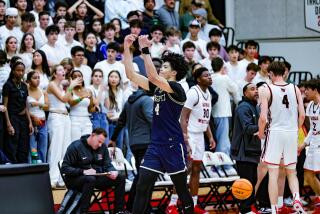These Kids Yearn to Learn : Summer Enrichment Program Offers Inner-City Youngsters Five Weeks of Hands-On Fun
- Share via
At more than $10,000 a year, the tuition at prestigious Harvard-Westlake School is a bit steep even for affluent Westside families.
But for 44 minority youngsters from the inner city this summer, the price is right: It’s absolutely free.
The students, who will be entering fifth and sixth grades this fall at 16 public schools, most of them in poor neighborhoods, are spending five weeks at the private school studying math, science and English with Harvard-Westlake’s regular teachers.
The all-day program also includes afternoon sports and arts and crafts activities at the middle school campus in the Bel-Air hills above UCLA and educational field trips to such places as a dairy farm and the La Brea tar pits.
Parents need only supply transportation and a sack lunch.
“We realize this kind of school--with its small classes and hands-on approach to learning--is not affordable for most people,” said Peg Burich, an English teacher and class dean who directs the summer enrichment program.
She said the $25,000 program, which uses 25 Harvard-Westlake high school students as volunteer aides, is an attempt to give something back to the community.
“I have as much to learn from these kids as they from me,” said senior Jake Wasserman, as he circulated among 14 kids weighing and measuring saltwater in the science lab last week. This is the second year the 17-year-old has helped in the program, which is drawing more attention now, in its fourth year, in the context of the Los Angeles riots.
Deirdre Zauss, also 17 and a senior, said the aides receive community service credit for volunteering. But she said she has a threefold reason for giving up her summer: “I’m in a program called the Black American Culture Club where we deal with racial issues, this is a way of putting something back (into Los Angeles) and I like working with the kids.”
More than two-thirds of the summer enrichment students are African-American, compared to only 8% of the regular Harvard-Westlake population, Burich said.
The youngsters were chosen from 150 applicants on the basis of two criteria: Their families could not afford a summer program and they had shown promise academically, as reflected in report cards, test scores and teacher recommendations.
Burich spread the word through calls to inner-city schools and to groups such as the I Have a Dream Foundation, A Better Chance and the Alliance for Minority Affairs.
What would they be doing otherwise? “I’d be at home, maybe doing some sports” said Sharif Joshua, 10, who attends Windsor Hills Magnet. He pronounced the summer program “better than school.”
So it was that last week Carmen Sorge’s class was solving tangrams (math puzzles), Jocelyn Medawar’s English class was discussing “Beowulf” and overcoming fear, and Bob Flowers’ science lab was awash in saltwater for a project on the conservation of mass.
Flowers said the small class sizes and motivated students make it possible to teach through what educators call discovery-based learning, allowing children to discover things at their own level. “They really like the ‘hands on,’ ” he said. “They’re more used to being told about science.”
Ten-year-old Jacqueline Chavez, for example, poured and measured and mixed and weighed solutions as she talked enthusiastically of graduated cylinders and “massing” substances and the need to measure exactly .
She said she especially likes going to classes taught by different teachers rather than the usual grade school practice of one teacher and classroom for nearly all subjects at her school, Virginia Road Elementary.
In the summer program, there are no grades, and classes are fun. Still, academic enrichment notwithstanding, it is afternoons that most of the kids like best.
“I could tap-dance on the desk,” sighed Sorge, “but no matter what you do, their favorite subject is still swimming .”
More to Read
Sign up for Essential California
The most important California stories and recommendations in your inbox every morning.
You may occasionally receive promotional content from the Los Angeles Times.













